With the discovery of the abundant reserve of CO2 and water on extraterrestrial sites, it has been proposed that photocatalytic CO2 conversion can also be implemented at extraterrestrial sites to build up the artificial carbon cycle for providing propellants and life supports for space missions. Credit: Chinese Journal of Catalysis
Today, space missions mainly rely on the transportation of basic needs from the Earth, which is extremely challenging and logistically impossible when we aim to develop stations or habitats on extraterrestrial sites such as the moon and Mars.
For example, an astronaut needs almost a kilogram of oxygen per day to sustain their life. Therefore, tons of oxygen have to be transported to build a station at extraterrestrial sites every year, raising the cost and risk of the mission. It is expected such a situation can be changed by building the artificial carbon cycle at these extraterrestrial sites.
On Earth, the carbon cycle allows the carbon atoms to move from the atmosphere (presenting in gaseous carbon compounds such as CO2 and CH4) to Earth (presenting in the form of sugar, starch, etc.), and finally back to the atmosphere to closed the loop.
The energy input of such a biogeochemical cycle is provided by solar energy, where plants or other organisms absorb the solar energy to convert CO2 and H2O into carbon-based compounds and oxygen via photosynthesis.
Given that the currently targeted extraterrestrial sites (i.e., the moon and Mars) enjoy abundant sunlight irradiation and have shown abundant CO2 and H2O reserves, such a photosynthesis strategy can be adopted to build up artificial carbon cycle system at extraterrestrial sites for providing sufficient propellants and life supports for space missions.
Given this background, artificial photosynthesis through photocatalytic CO2 conversion holds great promise to achieve a sustainable cycle. Specifically, such a strategy can imitate the role of green plants' photosynthesis and is expected to reconstruct the carbon cycle in nature on Earth, which is currently interrupted due to excess CO2 emission.
This artificial photosynthesis strategy, if it is successfully implemented at extraterrestrial sites as a part of ISRU, can also allow the artificial carbon cycle to be built at the extraterrestrial sites. Up to today, various products have been successfully produced through photocatalytic CO2 conversions, such as CO, CH4, CH3OH, and HCHO.
Nevertheless, the photocatalytic CO2 conversion efficiency remains dissatisfying to meet the practical applications. Thus, the development of photocatalytic CO2 conversion with excellent photoconversion efficiency and product selectivity is highly sought for its applications not only on the Earth but also on extraterrestrial sites.
Recently, a research team lead by Prof. Yujie Xiong from University of Science and Technology of China published a commentary on extraterrestrial photocatalytic CO2 conversion to provide brief and clear guidelines for the development of photocatalytic CO2 conversion and its application beyond the Earth.
They first outlined the fundamental and general principles of photocatalytic CO2 conversion. Then, they summarized the problems that can be encountered by photocatalysis during its implementation at extraterrestrial sites. Finally, perspectives on the development in this field were provided. The results were published in Chinese Journal of Catalysis.
More information: Jingxiang Low et al, Photocatalytic CO2 conversion: Beyond the earth, Chinese Journal of Catalysis (2023). DOI: 10.1016/S1872-2067(23)64472-9
Provided by Chinese Academy of Sciences
























